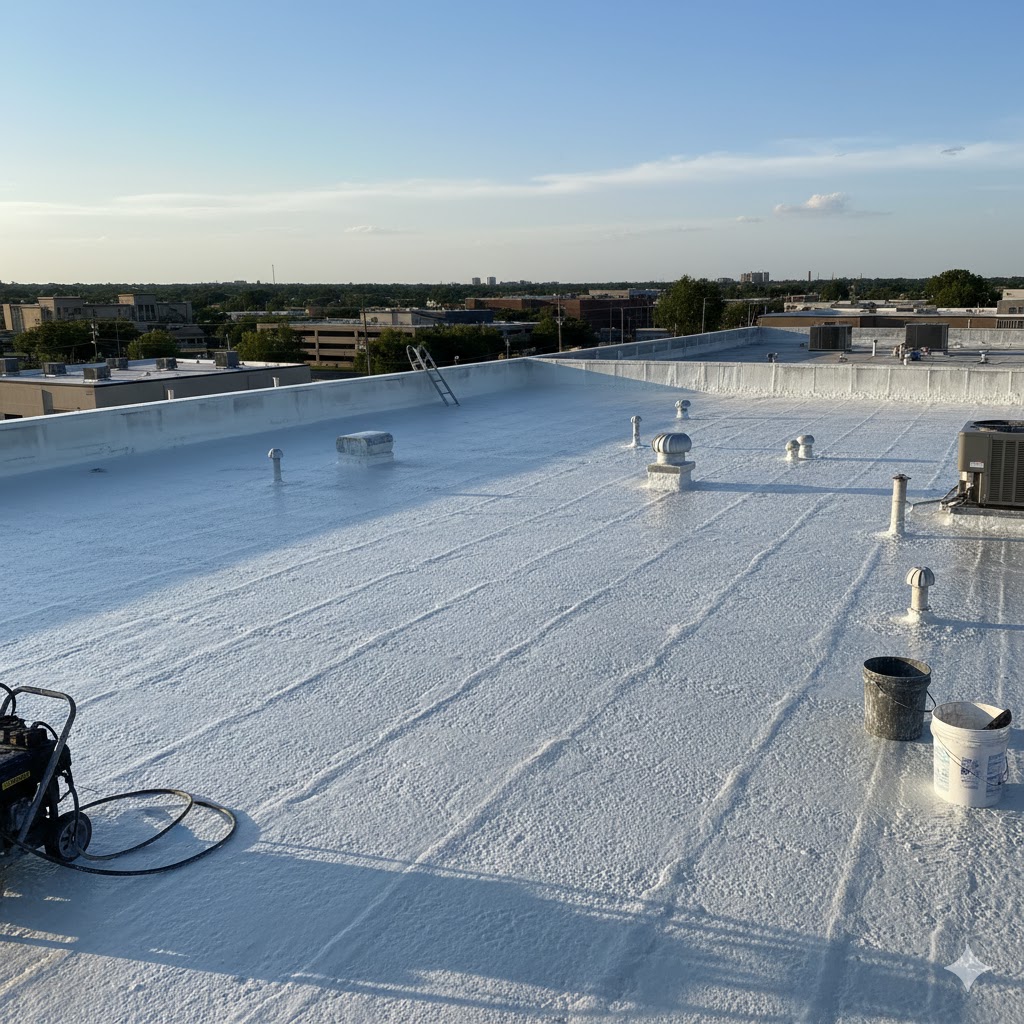What is a Spray Foam Roof System?
So, what exactly is this spray foam roof installation we’re talking about? It’s a liquid material that, when sprayed onto a roof, expands and hardens into a solid, seamless layer. Think of it like a custom-fit blanket for your house, but way more durable and protective. This isn’t some brand-new fad; spray polyurethane foam (SPF) has been around for a while, but it’s really gained traction in recent years for its impressive performance.
Unlike traditional roofing materials that come in sheets or shingles, spray foam roofing is applied in a liquid state. This allows it to conform to every nook and cranny of your roof, including vents, pipes, and complex angles. Once it cures, it forms a solid, monolithic barrier.
Here’s a quick rundown of what makes it different:
- Application: Sprayed on as a liquid, it expands into foam.
- Structure: Creates a single, continuous layer with no seams.
- Material: Typically a type of polyurethane foam.
- Result: A rigid, insulating, and waterproof surface.
This unique application method is a big part of why it’s becoming so popular, especially for homes with flat or low-sloped roofs where traditional materials can sometimes struggle. It’s a pretty neat process that offers a lot of advantages over older methods. You can learn more about spray foam roofing and how it works.
The key advantage is its ability to create a completely sealed surface. This means no gaps for water to seep through and no weak points where leaks can start. It’s a pretty straightforward concept, but the results are anything but simple.
The Benefits of Spray Foam Roofing for Your Home

When you’re thinking about your roof, it’s easy to just see it as a cover. But it’s doing a lot more than that, especially when it comes to keeping your home comfortable and saving you money. The benefits of spray foam roofing really stand out when you compare it to older methods. It’s not just about keeping the rain out; it’s about creating a better-performing home overall.
Superior Insulation and Energy Efficiency
This is a big one. Spray foam creates an incredibly tight seal. Unlike other materials that might leave small gaps, spray foam expands to fill every nook and cranny. This means less air can escape your home, whether it’s warm air in the winter or cool air in the summer. Think about how much less your heating and cooling systems will have to work. The U.S. Department of Energy suggests that good insulation can cut heating and cooling costs by up to 30%. Spray foam’s high R-value, which measures its resistance to heat flow, is a key reason it’s so effective. It helps keep your home at a steady temperature, making it more comfortable year-round and noticeably reducing those energy bills.
Exceptional Durability and Longevity
Roofs take a beating from the weather. Spray foam holds up really well against the elements. It doesn’t crack or warp like some other materials can. Because it’s applied as a liquid and then expands, it forms a single, solid layer with no seams. This lack of joints is a major advantage because seams are often where leaks start. A properly installed spray foam roof can last for decades, often 20 to 30 years. This means you’re not looking at frequent repairs or the big expense of a full roof replacement anytime soon. It’s an investment that pays off over time.
Seamless, Waterproof Barrier
Water damage is a homeowner’s nightmare. Spray foam roofing creates a completely waterproof surface. Once it cures, it forms a tough, flexible barrier that water just can’t get through. Even if your roof has a slight slope, the spray foam application helps direct water away, preventing it from pooling. This is super important, especially in areas that get a lot of rain or snow. It stops leaks before they even have a chance to start, protecting your home’s structure and preventing mold and mildew growth.
Environmentally Friendly Choice
Making eco-conscious choices is becoming more important for many people. Spray foam roofing can be a good option for this. By making your home more energy-efficient, you’re naturally reducing your carbon footprint because less energy is being used. Plus, the materials themselves are often made with recycled or renewable components. When it’s installed, there’s also less waste compared to some traditional roofing methods. So, switching to spray foam is good for your home and good for the planet.
Reduced Maintenance Needs
Let’s face it, nobody wants to spend a lot of time or money on roof maintenance. Spray foam roofs are known for being low-maintenance. Instead of needing constant attention, they often just need a recoating every few years to keep them in top shape. This means you can avoid the hassle and expense of major roof repairs or replacements for a long time. Regular check-ups are usually all that’s needed to make sure everything is functioning as it should, giving you peace of mind.
How Spray Foam Roofing Compares to Traditional Materials
When you’re thinking about roofing, it’s easy to get stuck on the usual suspects like shingles or metal. But spray foam roofing is really shaking things up, especially for homes with flat or low-sloped roofs. It’s a different beast altogether compared to what most people are used to.
Spray Foam vs. Asphalt Shingles
Asphalt shingles are what most folks picture when they think of a roof. They’re common, and for good reason – they’re usually the cheapest to put on initially. But that low upfront cost can be a bit of a trap. Shingles can be prone to damage from hail, wind, and even just the sun beating down over time. They have seams and overlaps where water can eventually find its way in, leading to leaks and rot. Plus, they don’t offer much in the way of insulation, so your heating and cooling bills can go up.
Spray foam, on the other hand, is applied as a liquid that expands into a solid, seamless layer. This means no weak spots for water to get through. It’s like giving your house a perfectly fitted, waterproof jacket. Because it seals everything up so well, it’s also a fantastic insulator, which can really cut down on energy costs. While the initial cost might be higher than shingles, the longevity and energy savings often make it a better deal over the long haul. You also avoid the constant worry about wind lifting shingles or water pooling.
Spray Foam vs. Metal Roofing
Metal roofing has gained popularity for its durability and sleek look. It’s strong, can last a long time, and is pretty good at shedding snow and rain. However, metal roofs can be noisy when it rains or hails, and they can dent. They also expand and contract with temperature changes, which can sometimes lead to issues if not installed perfectly. For flat roofing applications, metal can sometimes have issues with water ponding if the slope isn’t quite right.
Spray foam offers a different kind of durability. It’s incredibly tough once cured, and its seamless nature means there are no joints to worry about. It also provides excellent insulation, something most metal roofs don’t offer on their own. While metal is good at reflecting heat, spray foam actively stops heat transfer, keeping your home cooler in the summer and warmer in the winter. For homeowners looking for a truly waterproof and highly insulating solution, especially on flat roofing projects, spray foam really stands out.
When comparing roofing materials, think beyond just the price tag. Consider the total cost of ownership, including energy savings, maintenance, and how long the roof will actually last. Spray foam often wins out in these long-term calculations.
Here’s a quick look at some key differences:
- Insulation Value (R-Value): Spray foam is a top performer, significantly outperforming standard metal or shingle roofs. This means less energy escaping your home.
- Waterproofing: Spray foam creates a monolithic, seamless barrier. Metal and shingles rely on overlaps and seals that can degrade over time.
- Installation Complexity: While both require professionals, spray foam application is a specialized process that needs precise conditions and expertise.
- Noise: Metal roofs can be noisy during storms. Spray foam is generally much quieter.
Is a Spray Foam Roof Right for Your Home?
So, you’re thinking about spray foam for your roof. That’s a big step, and it’s smart to figure out if it’s the best fit for your place. Spray foam for roofing is a pretty unique system, and it works best on certain types of homes.
Think about your current roof. Is it flat or does it have a low slope? Spray foam really shines in these situations because it creates a solid, seamless layer that water just can’t get through. If you’ve had issues with pooling water or leaks, this could be a game-changer. It’s also a good option if you’re looking to improve your home’s energy efficiency. That foam layer acts like a super-insulator, keeping your house cooler in the summer and warmer in the winter, which can really cut down on your energy bills.
Here are a few things to consider:
- Roof Type: Best for flat or low-sloped roofs. Not ideal for very steep pitches where water runs off quickly anyway.
- Existing Roof Condition: If your current roof is in decent shape, spray foam can often be applied right over it, saving you the cost and hassle of a full tear-off. This can be a big plus for roof repair jobs.
- Climate: If you live somewhere with extreme temperatures or heavy rain, the insulation and waterproofing benefits are even more significant.
- Budget: While the upfront cost might be higher than some traditional options, the long-term savings on energy and reduced maintenance can make it a very cost-effective choice over time.
Spray foam roofing creates a single, continuous barrier. This means no seams for water to sneak through, which is a common problem with other roofing materials. It also expands to fill every nook and cranny, making it great for roofs with lots of pipes, vents, or other things sticking out.
If you’re still on the fence, it’s always a good idea to get a few quotes from experienced spray foam roofing contractors. They can assess your specific roof and tell you if spray foam is the right move for your home.
Making the Switch: What to Expect

So, you’re thinking about going with a spray foam roof. That’s a big step, and it’s good you’re doing your homework. When you decide to make the switch, there are a few things to keep in mind to make sure everything goes smoothly.
First off, picking the right contractor is super important. This isn’t a DIY job for most people. You want someone licensed, insured, and with a solid track record, specifically with spray foam. A good installer knows how to prep the roof deck properly – making sure it’s clean, dry, and structurally sound. Any old leaks or weak spots need to be fixed before the foam goes on. It’s like building a house; you need a strong foundation.
Weather plays a role, too. Spray foam needs specific conditions to cure right. Ideally, you want temperatures above 50°F and no rain or heavy dew. High winds can also mess with the application. Spring and fall are often the best times for installation because the weather is usually more stable.
Here’s a quick rundown of what to expect during the process:
- Roof Assessment: The contractor will check your current roof’s condition.
- Surface Preparation: Cleaning, repairing, and priming if needed.
- Application: The foam is sprayed on, expanding to fill gaps and create a seamless layer.
- Curing: The foam hardens, forming a solid, protective barrier.
- Top Coating: A protective coating is usually applied over the foam for added UV protection and durability.
The upfront cost might seem higher than traditional roofing, but it’s really about the long game. Think about the energy savings from better insulation and the reduced need for repairs down the line. Many homeowners find that a spray foam roof pays for itself over time.
Finally, remember that even though spray foam roofs are low maintenance, they aren’t zero maintenance. Plan for regular inspections, especially after big storms, and address any small issues promptly. With the right care, your new spray foam roof can last for decades.
Frequently Asked Questions
What exactly is spray foam roofing?
Spray foam roofing is a special kind of roof coating. It’s put on as a liquid that then puffs up into a solid foam. This creates a strong, seamless layer that helps keep your house dry and at a good temperature.
How does spray foam help save energy?
The foam creates a tight seal, like a blanket for your roof. This stops air from getting in or out, so your heating and cooling systems don’t have to work as hard. This means lower electricity bills and a more comfortable home all year round.
Is spray foam roofing tough and long-lasting?
Yes, it’s known for being very durable! Unlike older roofing materials that can crack or break, spray foam is flexible and resists damage from weather. A well-installed spray foam roof can last for many years, often 30 years or more.
Can spray foam be put over my existing roof?
In many cases, yes! Spray foam can often be sprayed right over old roofs made of materials like metal or asphalt. The key is that the old roof needs to be solid and in good shape first. A professional will check this before starting.
Does this roofing cost more than other roofs?
It might cost more at first than some traditional roofs. But, when you think about how much you’ll save on energy bills and fewer repairs over many years, it often ends up being cheaper in the long run. It’s a smart investment.
What kind of upkeep does a spray foam roof need?
Spray foam roofs don’t need a lot of fixing, but they do need some care. It’s a good idea to have it checked twice a year, especially after big storms. Keeping it clean and fixing any small issues right away will help it last even longer.

